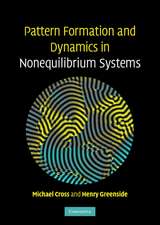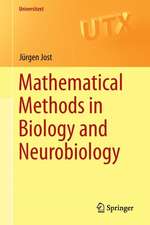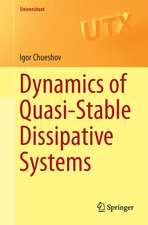Cellular Automata and Groups: Springer Monographs in Mathematics
Autor Tullio Ceccherini-Silberstein, Michel Coornaerten Limba Engleză Hardback – 14 ian 2024
Entirely self-contained and now in its second edition, the volume includes 10 appendices and more than 600 exercises, the solutions of which are presented in the companion book Exercises in Cellular Automata and Groups (2023) by the same authors. It will appeal to a large audience, including specialists and newcomers to the field.
| Toate formatele și edițiile | Preț | Express |
|---|---|---|
| Paperback (1) | 666.39 lei 38-44 zile | |
| Springer Berlin, Heidelberg – 5 noi 2012 | 666.39 lei 38-44 zile | |
| Hardback (2) | 547.91 lei 6-8 săpt. | |
| Springer International Publishing – 14 ian 2024 | 547.91 lei 6-8 săpt. | |
| Springer Berlin, Heidelberg – 3 sep 2010 | 715.24 lei 6-8 săpt. |
Din seria Springer Monographs in Mathematics
- 18%
 Preț: 1234.77 lei
Preț: 1234.77 lei - 18%
 Preț: 753.23 lei
Preț: 753.23 lei - 20%
 Preț: 574.70 lei
Preț: 574.70 lei - 24%
 Preț: 740.03 lei
Preț: 740.03 lei - 24%
 Preț: 777.43 lei
Preț: 777.43 lei - 20%
 Preț: 818.29 lei
Preț: 818.29 lei - 18%
 Preț: 969.93 lei
Preț: 969.93 lei - 20%
 Preț: 758.03 lei
Preț: 758.03 lei - 9%
 Preț: 904.20 lei
Preț: 904.20 lei - 15%
 Preț: 607.33 lei
Preț: 607.33 lei - 8%
 Preț: 529.41 lei
Preț: 529.41 lei - 24%
 Preț: 1598.61 lei
Preț: 1598.61 lei -
 Preț: 396.40 lei
Preț: 396.40 lei - 18%
 Preț: 793.14 lei
Preț: 793.14 lei - 15%
 Preț: 650.86 lei
Preț: 650.86 lei - 18%
 Preț: 1236.19 lei
Preț: 1236.19 lei - 15%
 Preț: 499.77 lei
Preț: 499.77 lei -
 Preț: 391.61 lei
Preț: 391.61 lei - 18%
 Preț: 1404.30 lei
Preț: 1404.30 lei - 18%
 Preț: 797.24 lei
Preț: 797.24 lei - 18%
 Preț: 916.25 lei
Preț: 916.25 lei -
 Preț: 397.01 lei
Preț: 397.01 lei - 15%
 Preț: 657.25 lei
Preț: 657.25 lei - 15%
 Preț: 467.79 lei
Preț: 467.79 lei - 15%
 Preț: 648.05 lei
Preț: 648.05 lei -
 Preț: 406.25 lei
Preț: 406.25 lei -
 Preț: 389.88 lei
Preț: 389.88 lei - 15%
 Preț: 649.54 lei
Preț: 649.54 lei - 15%
 Preț: 581.14 lei
Preț: 581.14 lei - 15%
 Preț: 643.48 lei
Preț: 643.48 lei - 15%
 Preț: 647.73 lei
Preț: 647.73 lei - 18%
 Preț: 902.55 lei
Preț: 902.55 lei - 15%
 Preț: 653.33 lei
Preț: 653.33 lei - 18%
 Preț: 901.88 lei
Preț: 901.88 lei - 18%
 Preț: 907.27 lei
Preț: 907.27 lei - 18%
 Preț: 893.53 lei
Preț: 893.53 lei - 15%
 Preț: 659.53 lei
Preț: 659.53 lei - 18%
 Preț: 802.28 lei
Preț: 802.28 lei - 15%
 Preț: 661.32 lei
Preț: 661.32 lei - 15%
 Preț: 646.62 lei
Preț: 646.62 lei -
 Preț: 384.48 lei
Preț: 384.48 lei - 15%
 Preț: 704.36 lei
Preț: 704.36 lei - 18%
 Preț: 1248.20 lei
Preț: 1248.20 lei - 18%
 Preț: 1031.17 lei
Preț: 1031.17 lei -
 Preț: 409.13 lei
Preț: 409.13 lei - 18%
 Preț: 986.01 lei
Preț: 986.01 lei - 15%
 Preț: 640.37 lei
Preț: 640.37 lei - 15%
 Preț: 643.34 lei
Preț: 643.34 lei -
 Preț: 388.72 lei
Preț: 388.72 lei - 18%
 Preț: 965.34 lei
Preț: 965.34 lei
Preț: 547.91 lei
Preț vechi: 644.61 lei
-15% Nou
Puncte Express: 822
Preț estimativ în valută:
104.84€ • 114.24$ • 88.35£
104.84€ • 114.24$ • 88.35£
Carte tipărită la comandă
Livrare economică 23 aprilie-07 mai
Preluare comenzi: 021 569.72.76
Specificații
ISBN-13: 9783031433276
ISBN-10: 3031433270
Pagini: 556
Ilustrații: XXI, 556 p. 56 illus.
Dimensiuni: 155 x 235 x 38 mm
Greutate: 0.98 kg
Ediția:2nd ed. 2023
Editura: Springer International Publishing
Colecția Springer
Seria Springer Monographs in Mathematics
Locul publicării:Cham, Switzerland
ISBN-10: 3031433270
Pagini: 556
Ilustrații: XXI, 556 p. 56 illus.
Dimensiuni: 155 x 235 x 38 mm
Greutate: 0.98 kg
Ediția:2nd ed. 2023
Editura: Springer International Publishing
Colecția Springer
Seria Springer Monographs in Mathematics
Locul publicării:Cham, Switzerland
Cuprins
1 Cellular Automata.- 2 Residually Finite Groups.- 3 Surjunctive Groups.- 4 Amenable Groups.- 5 The Garden of Eden Theorem.- 6 Finitely Generated Groups.- 7 Local Embeddability and Sofic Groups.- 8 Linear Cellular Automata.- Appendix A: Nets and the Tychonoff Product Theorem.- Appendix B: Uniform Structures.- Appendix C: Symmetric Groups.- Appendix D: Free Groups.- Appendix E: Inductive Limits and Projective Limits of Groups.- Appendix G: The Markov-Kakutani Fixed Point Theorem.- Appendix I: Complements of Functional Analysis.
Notă biografică
Tullio Ceccherini-Silberstein graduated from the University of Rome La Sapienza in 1990 and obtained his PhD in mathematics from the University of California at Los Angeles in 1994. Since 1997 he has taught at the University of Sannio, Benevento (Italy). His main interests include harmonic and functional analysis, geometric and combinatorial group theory, ergodic theory and dynamical systems, and theoretical computer science. He is an editor of the journal Groups, Geometry, and Dynamics, published by the European Mathematical Society. He has published more than 90 research papers, 9 monographs, and 4 conference proceedings.
Professor Michel Coornaert taught mathematics at the University of Strasbourg from 1992 until 2021. His research interests are in geometry, topology, group theory and dynamical systems. He is the author of many Springer volumes, including Topological Dimension and Dynamical Systems (2015), Cellular Automata and Groups (2010), Symbolic Dynamics and Hyperbolic Groups (1993) and Géométrie et théorie des groupes (1990).
Professor Michel Coornaert taught mathematics at the University of Strasbourg from 1992 until 2021. His research interests are in geometry, topology, group theory and dynamical systems. He is the author of many Springer volumes, including Topological Dimension and Dynamical Systems (2015), Cellular Automata and Groups (2010), Symbolic Dynamics and Hyperbolic Groups (1993) and Géométrie et théorie des groupes (1990).
Textul de pe ultima copertă
This unique book provides a self-contained exposition of the theory of cellular automata on groups and explores its deep connections with recent developments in geometric and combinatorial group theory, amenability, symbolic dynamics, the algebraic theory of group rings, and other branches of mathematics and theoretical computer science. The topics treated include the Garden of Eden theorem for amenable groups, the Gromov–Weiss surjunctivity theorem, and the solution of the Kaplansky conjecture on the stable finiteness of group rings for sofic groups.
Entirely self-contained and now in its second edition, the volume includes 10 appendices and more than 600 exercises, the solutions of which are presented in the companion book Exercises in Cellular Automata and Groups (2023) by the same authors. It will appeal to a large audience, including specialists and newcomers to the field.
Entirely self-contained and now in its second edition, the volume includes 10 appendices and more than 600 exercises, the solutions of which are presented in the companion book Exercises in Cellular Automata and Groups (2023) by the same authors. It will appeal to a large audience, including specialists and newcomers to the field.
Caracteristici
The second edition of a unique monograph on symbolic dynamics and geometric group theory Entirely self-contained, it will appeal to specialists as well as newcomers Contains more than 600 exercises whose solutions appear in a companion book
Recenzii
From the reviews:
“The book under review is currently the only text of comparable size and level which devotes its attention to the general case of cellular automata on arbitrary groups … . The book is a great read and a great resource. … The basic material is supported by a trove of exercises (over 300) and notes at the end of each chapter, and the book ends with a selection of 17 open problems.” (Zoran Šunić, Bulletin of the American Mathematical Society, Vol. 51 (2), April, 2014)
“An excellent introduction to the subject of cellular automata on groups, complete with copious exercises. … I like this book very much. The authors have set out to write a self-contained account, and I think they have succeeded. … This is done using conventional notation and without idiosyncrasy, which to mind is important for any reader wanting to supplement their reading using other sources. All this is done whilst presenting some very recent material – a real achievement.” (Charles Eaton, The Mathematical Gazette, Vol. 97 (539), July, 2013)
“The book explores deep connections between two seemingly unrelated mathematical notions, both of which were introduced by J. von Neumann in the first half of the 20th century … . The book is well written and develops very carefully the state of the art of the material sketched above … . It is essentially self-contained … and each chapter contains informative historical notes and a long list of instructive exercises.” (K. Auinger, Monatshefte für Mathematik, Vol. 164 (3), November, 2011)
“This book should be considered as self-contained, in the sense that all the concepts used are developed at length, together with a large choice of exercises. … should make an important contribution to a field in rapid development, and which is at the intersection of algebra, analysis and computer science. It is carefully written, and is especially recommended to graduate students andresearchers, who will find out in what way so many apparently distant concepts can fit together to make this fascinating theory.” (Antonio Machì, Bulletin of the London Mathematical Society, July, 2011)
“This wonderful book is about important links between four areas of mathematics: geometric group theory, theory of cellular automata, dynamical systems and amenability. … the notions are clearly defined and illustrated by several examples and figures, and the proofs of all results are very carefully detailed and presented in an elegant form. For all these reasons I strongly recommend this brilliant book to both experts and students from all the areas of mathematics mentioned in this review, as well as many others.” (Rostislav I. Grigorchuk, Mathematical Reviews, Issue 2011 j)
“The book discusses these and related topics from the theory of cellular automata on groups and explores its deep connections with recent developments in geometric group theory, symbolic dynamics and theoretical computer science. … The book has 8 chapters, 10 appendices and more than 300 exercises. It is oriented towards a broad audience, and shall be useful for experts as a detailed comprehensive account of the recent progress in the field.” (Boris S. Kruglikov, Zentralblatt MATH, Vol. 1218, 2011)
“The book under review is currently the only text of comparable size and level which devotes its attention to the general case of cellular automata on arbitrary groups … . The book is a great read and a great resource. … The basic material is supported by a trove of exercises (over 300) and notes at the end of each chapter, and the book ends with a selection of 17 open problems.” (Zoran Šunić, Bulletin of the American Mathematical Society, Vol. 51 (2), April, 2014)
“An excellent introduction to the subject of cellular automata on groups, complete with copious exercises. … I like this book very much. The authors have set out to write a self-contained account, and I think they have succeeded. … This is done using conventional notation and without idiosyncrasy, which to mind is important for any reader wanting to supplement their reading using other sources. All this is done whilst presenting some very recent material – a real achievement.” (Charles Eaton, The Mathematical Gazette, Vol. 97 (539), July, 2013)
“The book explores deep connections between two seemingly unrelated mathematical notions, both of which were introduced by J. von Neumann in the first half of the 20th century … . The book is well written and develops very carefully the state of the art of the material sketched above … . It is essentially self-contained … and each chapter contains informative historical notes and a long list of instructive exercises.” (K. Auinger, Monatshefte für Mathematik, Vol. 164 (3), November, 2011)
“This book should be considered as self-contained, in the sense that all the concepts used are developed at length, together with a large choice of exercises. … should make an important contribution to a field in rapid development, and which is at the intersection of algebra, analysis and computer science. It is carefully written, and is especially recommended to graduate students andresearchers, who will find out in what way so many apparently distant concepts can fit together to make this fascinating theory.” (Antonio Machì, Bulletin of the London Mathematical Society, July, 2011)
“This wonderful book is about important links between four areas of mathematics: geometric group theory, theory of cellular automata, dynamical systems and amenability. … the notions are clearly defined and illustrated by several examples and figures, and the proofs of all results are very carefully detailed and presented in an elegant form. For all these reasons I strongly recommend this brilliant book to both experts and students from all the areas of mathematics mentioned in this review, as well as many others.” (Rostislav I. Grigorchuk, Mathematical Reviews, Issue 2011 j)
“The book discusses these and related topics from the theory of cellular automata on groups and explores its deep connections with recent developments in geometric group theory, symbolic dynamics and theoretical computer science. … The book has 8 chapters, 10 appendices and more than 300 exercises. It is oriented towards a broad audience, and shall be useful for experts as a detailed comprehensive account of the recent progress in the field.” (Boris S. Kruglikov, Zentralblatt MATH, Vol. 1218, 2011)











